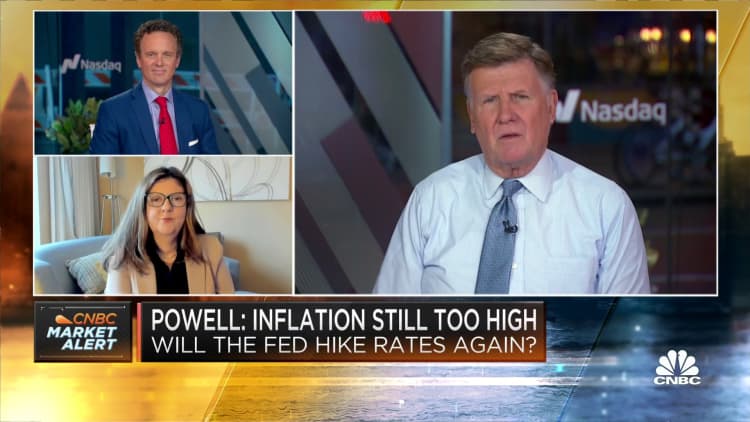People shop along Broadway in Manhattan on July 27, 2023 in New York City.
Spencer Platt | Getty Images
The U.S. economy likely turned in another strong performance heading into the final part of the year, though what’s ahead could be significantly different.
Gross domestic product, or the sum of all goods and services produced in the U.S. economy, is expected to post a 4.7% annualized gain for the third quarter, according to a Dow Jones consensus estimate. The Commerce Department will release its first estimate of GDP at 8:30 a.m. ET.
If the projection is correct, it will be the strongest output since the fourth quarter of 2021, when growth was just shy of 7%.
However, policymakers, economists and markets will be focused more on forward-looking signals from an economy that repeatedly has defied expectations.
“We ought to look at whatever we print in the third quarter with a large degree of suspicion,” said Joseph LaVorgna, chief economist at SMBC Nikko Securities America. “GDP doesn’t tell us where we’re going. We can feel all warm and fuzzy about a good number. But the real problem is what’s next.”
For much of the past two years, economists have been waiting for the economy to slow down and possibly enter a recession. In fact, the the Federal Reserve itself had been forecasting a mild contraction, but retracted that recently in the wake of resilient consumer that has kept growth afloat.
That’s expected to be the case again in the July-through-September period.
The consumer keeps consuming
The Atlanta Fed employs a growth tracker it calls GDPNow, which takes in data on a real-time basis and adjusts its projections accordingly. Over the past two years or so, the gauge has had a good track record, outperforming consensus nine of the past 10 quarters, according to recent research from Goldman Sachs.
For Q3, GDPNow is projecting growth of 5.4%, with more than half — 2.77 percentage points — to come from consumer spending. Exports are expected to contribute about 1 percentage point, while inventories are projected to add 0.7 point.
LaVorgna, a top White House economist under former President Donald Trump, thinks the consumer will be responsible for more than three-fourths of what he expects to be a 4.1% GDP gain. However, he thinks higher borrowing costs and a general expected pullback in demand for big-ticket items ahead finally could start putting a hit on demand metrics.
“The income side of the data shows the economy is much softer,” LaVorgna said. “To me, there’s a lot on the docket that suggests, as excited as we want to get for Q3, that definitely might be the last pop in growth that we see for a while.”
To be sure, the economy and its pivotal consumer component have been written off before.
Starting in early 2022, there had been a strong Wall Street consensus call that a recession was almost inevitable because of the lagged impact of higher interest rates. That expectation intensified during a brief banking industry crisis in March 2023 that the Fed expected would constrain credit enough to bring about a downturn.
But the Fed’s move to keep liquidity flowing in the sector, along with ambitious lending efforts from “shadow” nonbanks, helped get the economy through the crisis and keep growth afoot.
“This consumer feels comfortable spending money, they feel comfortable borrowing money,” said Steven Ricchiuto, U.S. chief economist at Mizuho Securities USA. “There is a lot of spending that is being done despite the interest rate environment. That comes from the fact that there is a tight labor market and people feel comfortable in their jobs.”
The economic ‘Energizer bunny’
Indeed, companies and the government continue to hire, putting upward pressure on growth and keeping the heat on the Fed to maintain higher rates to fight inflation. Central bank officials have raised rates aggressively while professing to not want to drag the economy into recession.
“The economy is like an Energizer bunny,” Ricchiuto said. “You have to find a way to stop it, and the Fed keeps on telling everybody they don’t really want to stop it.”
Markets, then, could interpret a strong GDP in a variety of ways.
They could see a beat as a sign that the Fed still has more work to do on inflation. Or they could view it as a sign that the economy can withstand higher rates and still grow. Or they could deem Thursday’s Commerce Department report as backward-looking and await more data for clues on the Fed’s next move.
Since mid-July 2022, the bond market has been sending a strong signal it thinks a recession is coming. Since that point, the yield on the two-year Treasury has eclipsed that of the 10-year note, a phenomenon called an inverted yield curve that has never failed to forecast a looming recession.
Now, the inversion has lessened sharply to the point where the curve is almost flat again — also a textbook sign that a recession is around the corner. That’s because after inverting, markets ultimately will start pricing in the slower or negative growth ahead through lower yields.
“The market is sending a message that a recession is coming and the Fed will have to lower rates,” said Quincy Krosby, chief global strategist at LPL Financial.
“What they’re trying to do is engineer a slowdown but keep the labor market intact,” she added. “Historically, that’s been difficult.”

Krosby expects markets to pay some attention to the GDP report but also focus on data Friday on consumer spending, sentiment and inflation, with the release of the Fed’s favorite gauge of price increases coming from the Commerce Department.
“Is the economy going to continue to defy historical trends, such as the unwinding of the inverted yield curve?” she said. “That’s the dilemma in this market.”

